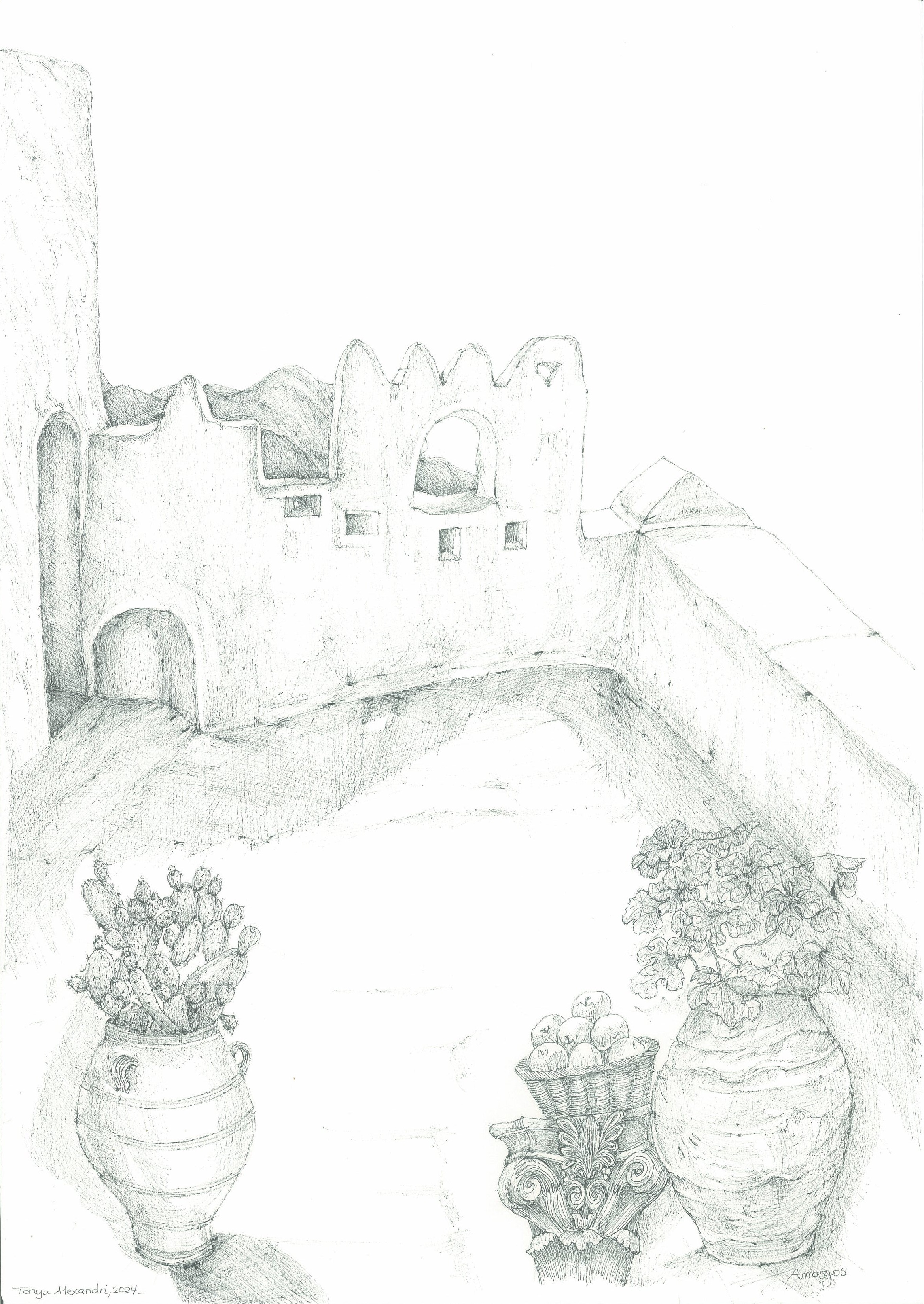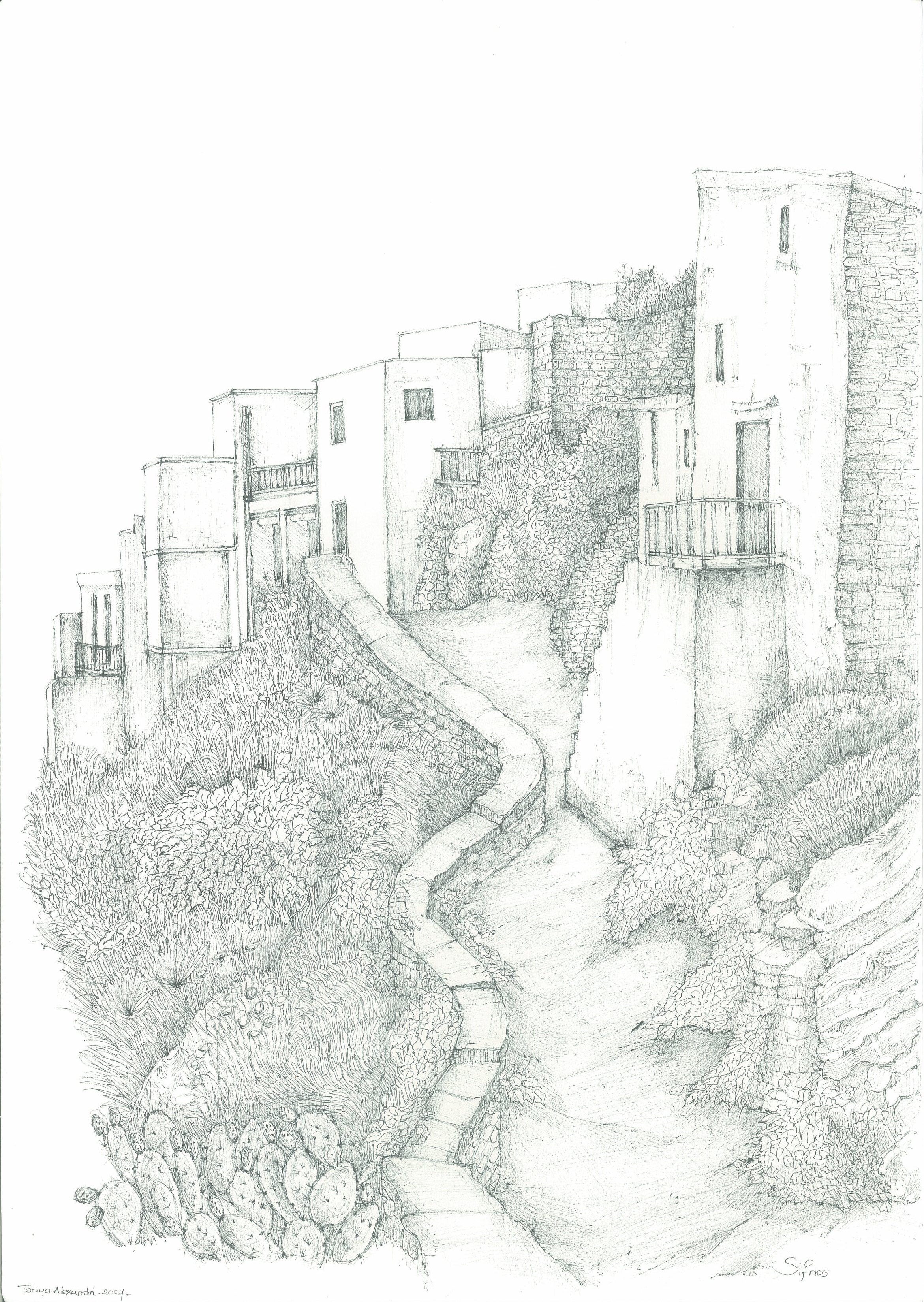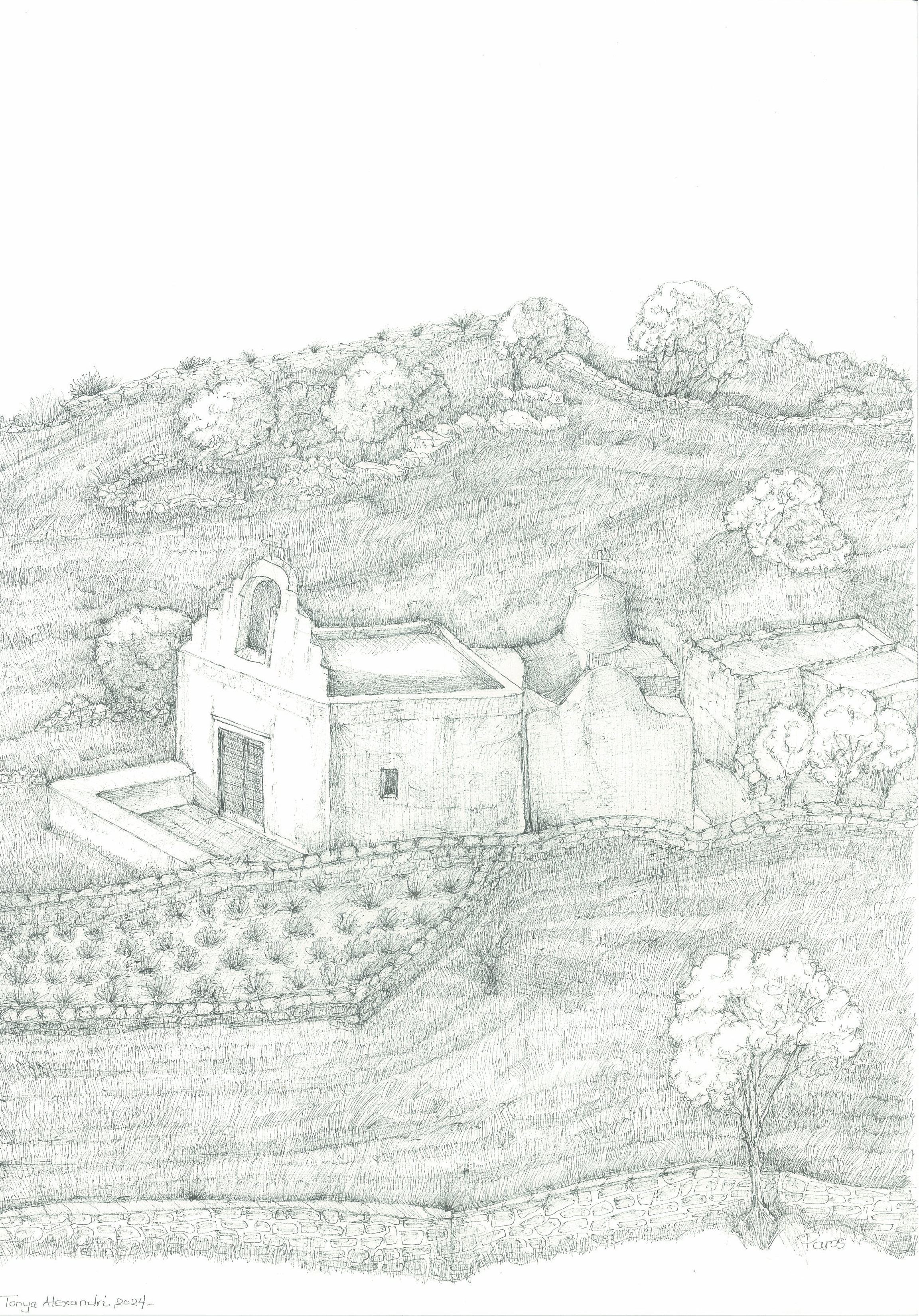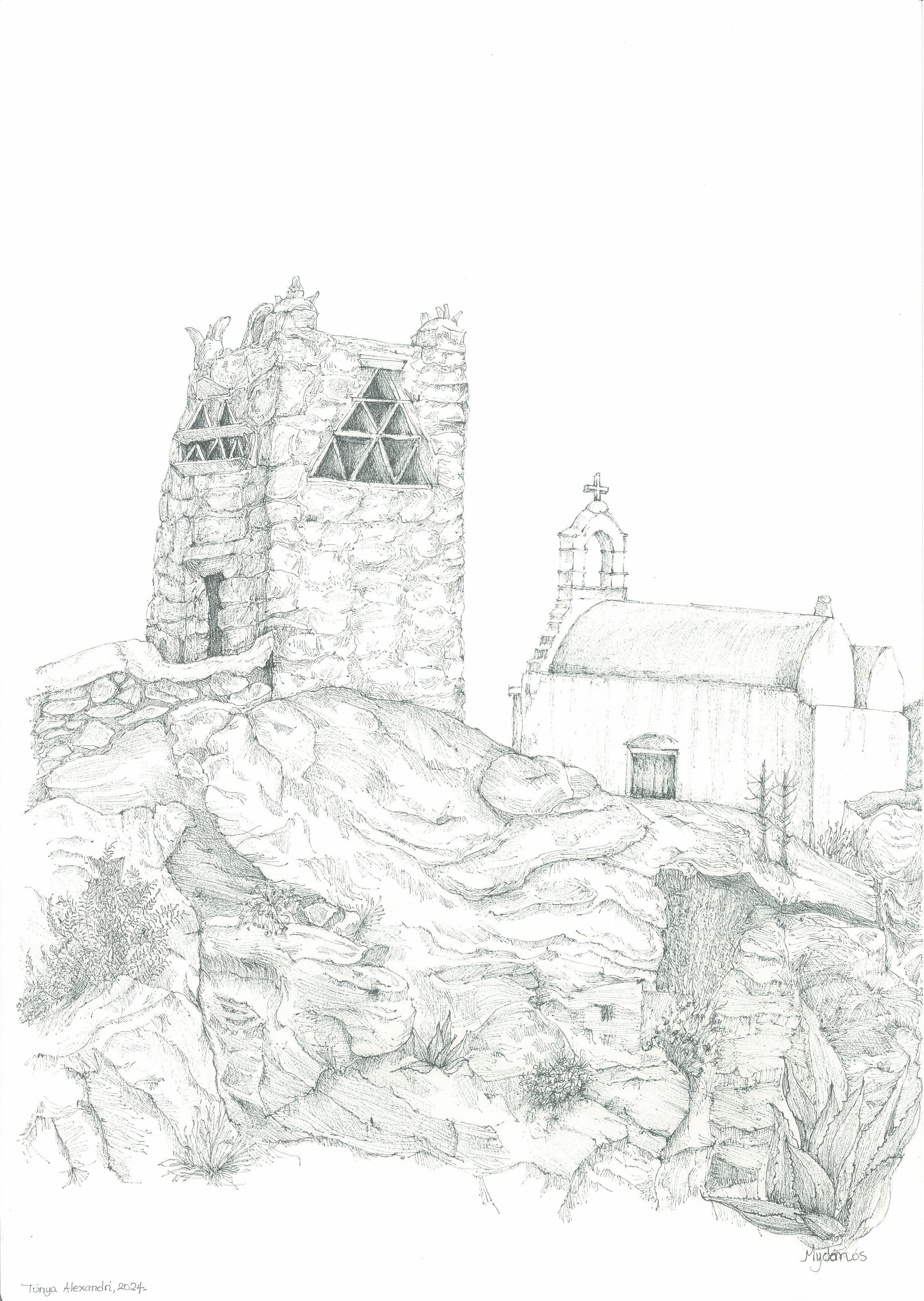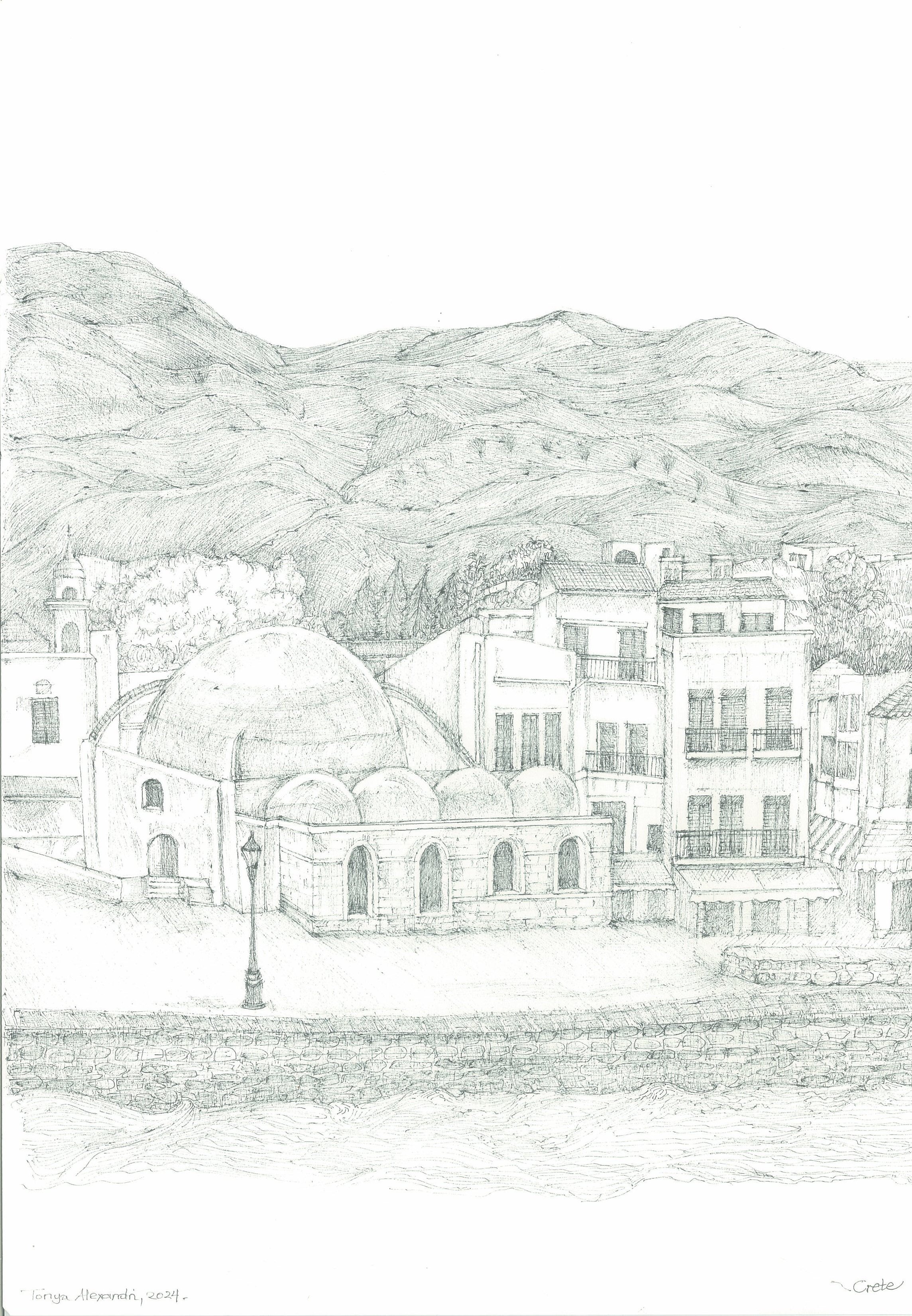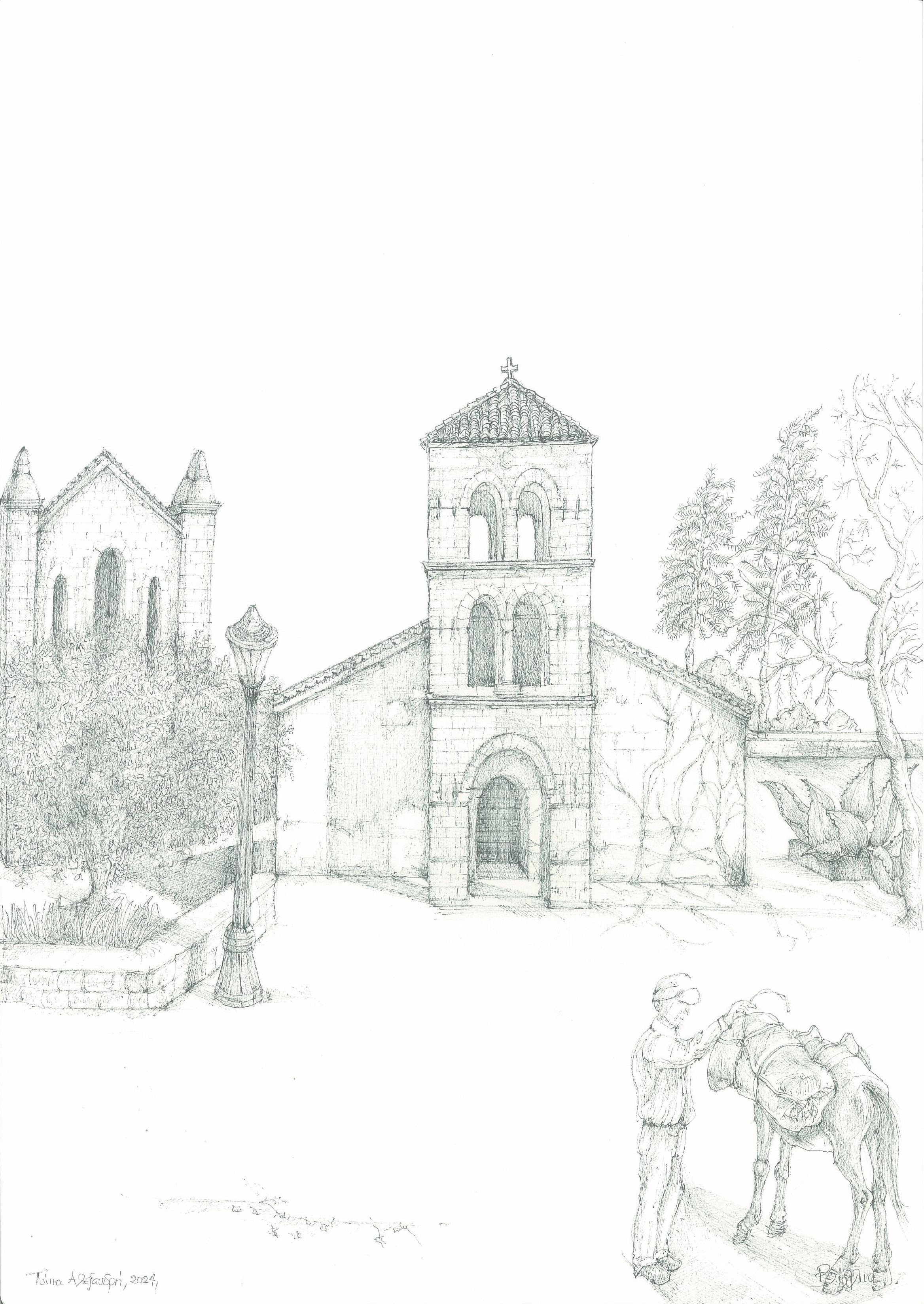PART THREE
Narrative Therapy
and
Art
“Therapists can undermine the idea that they have privileged access to the truth by consistently encouraging persons to assist them in the quest for understanding.” Michael White
“I believe, with Michel Foucault (1980), that a domain of knowledge is a domain of power, and that a domain of power is a domain of knowledge.” Michael White
This third part on narrative therapy is a continuation of the previous two posts, and it focuses on a few more ideas and papers in Michael White’s book, Narrative Therapy Classics.
I’m also posting some new ink drawings from a series with the title Τόποι / Places.
As I mentioned in the previous posts, the book is rich in themes, principles of narrative therapy, political analysis, questions and sample conversations, and is probably a book one needs to read more than once. In today’s piece I will attempt to briefly present some ideas and interventions related to loss and grief, trauma and subordinate storyline development, surface spiritualities, ethics and transparency in therapeutic contexts.
On loss and grief
In relation to experiences of loss and grief White discusses the value of utilizing both the “saying hullo” metaphor and the “saying goodbye” metaphor, when working with loss and grief. He writes that many people that have consulted him over problems related to grief have found the ‘saying hullo’ metaphor, and the questions derived from this metaphor, to be helpful. He claims that he has consistently found that, through the incorporation of the lost relationship, those problems that are often defined by the field, as ‘pathological mourning’ or ‘delayed grief ’are resolved and people arrive at a new relationship with their self.
White clarifies that he’s not taking a position against the utilisation of the saying goodbye metaphor because he believes there is a lot to say goodbye to. People often need to say goodbye to what was, to a material reality and to hopes, dreams and expectations. However, he believes that the process of grief is both a ‘saying goodbye and a ‘saying hullo’ phenomenon. He also argues that every experience of loss is unique, as are the requirements for its processing. Therefore, metaphors can be helpful to the extent that they don’t subject people to normative specifications, and to the extent that the expression of, this uniqueness is recognized and facilitated.
White also notes that at times it has been assumed that this work, which is oriented to the ‘saying hullo again’ metaphor, is informed by a notion of a spirituality that is immanent or ascendant, and that it is associated with forces that are of another dimension; however, this is not what he has intended to propose and these notions have not shaped the development of this particular work. He explains that work that is oriented by the ‘saying hullo again’ metaphor assists persons “in the development of skills in the resurrection and expression of significant experiences of their relationships. These are experiences that these persons have lived through – that are part of their stock of lived-experience”.
Additionally, White discusses how this metaphor provides possibilities for action in the form of re-membering practices, which inform a ‘special type of recollection.’ He quotes Myerhoff (1982), who claims that the term ‘Re-membering’ may involve the calling of attention to the re-aggregation of the figures who belong to one’s life story, one’s own prior selves, as well as significant others who are part of one’s story. In this sense, “Re-membering is a purposive, significant unification, quite different from the passive, continuous fragmentary flickerings of images and feelings that accompany other activities in the normal flow of consciousness “(Myerhoff cited in White). This notion of re-membering and the club metaphor, suggest possibilities for people to engage in a revision of the membership of their club of life. This process, White suggests, “provides persons with the opportunity to have a greater say about the status of particular memberships of their club of life. Through re-membering practices, persons can suspend or elevate, revoke or privilege, and downgrade or upgrade specific memberships of their lives.”
On children, trauma and subordinate storyline development
In his paper on children, trauma and subordinate storyline development White emphasizes the importance of subordinate storyline development when working with children, who have been subject to trauma and neglect, because it provides an alternative territory of identity for children to stand in as they begin to give voice to their experiences. He writes that it gives children a significant degree of immunity from the potential for re-traumatisation in response to therapeutic initiatives to assist them to speak of their experiences of trauma and its consequences.
He clarifies that in his own work with people who have been subjected to trauma and to a range of abuses, including political torture, and for people struggling with the consequences of a range of social calamities, including disease epidemics, he has not sought to attenuate their expressions of trauma and its consequences, nor has he been timid “in opening space for people to speak of what they have not had the opportunity to speak of, to put words to what has been unmentionable.” However, he emphasizes safety and notes that he has taken care to do what is within his understandings and skills to establish contexts in which “people can give full voice to their experiences of trauma in ways that enable them to wrest their lives from the prospective longer term consequences of this trauma” without being re-traumatised in the context of assisting them to address what they have been through.
White explains that the generation of subordinate storyline development is found in children’s responses to the trauma they have been subject to, because no child is a passive recipient of trauma, regardless of the nature of this trauma. Children, he writes, take action to minimise their exposure to trauma and to decrease their vulnerability to it by finding ways to modify the effects of this trauma on their lives; however, often their responses to the traumas are unacknowledged and unnoticed, or they are punished and diminished within the trauma context.
White writes: “These responses to trauma and its consequences are founded upon what children give value to, upon what they hold precious in their lives.” And these responses reflect knowledge and skills in:
“a. the preservation of life in life-threatening contexts, b. finding support in hostile environments, c. establishing domains of safety in unsafe places, d. holding onto possibilities for life in circumstances that are discouraging of this, e. developing nurturing responses to others in situations that are degrading of such responses, f. finding connection and a sense of affiliation with others in settings that are isolating, g. refusing to visit trauma g. refusing to visit trauma on the lives of others in milieus that are encouraging of this reproduction of trauma, h. healing from the consequences of trauma under conditions that are unfavourable to this, i. achieving degrees of self-acceptance in atmospheres that are sponsoring of self-rejection, j. and more.”
White discusses how direct observation of the spontaneous interaction of children who have been subject to trauma often provides clues about points of entry for subordinate storyline development. He provides various examples of his work with young people that had been through a lot and demonstrates how he assisted them in developing a subordinate storyline, which afforded alternative and relatively secure territories of identity for them to occupy.
In one instance, he initiated his work with three boys [who had migrated from their countries of origin as refugees and had been referred to him on account of concerns about their being withdrawn, and about the extent to which they had continued to maintain silence in regard to the very significant trauma that they had been subject to over an extended period ahead of their migration] by consulting them about whether they’d like to talk about what they held precious, and what they intended for their lives, along with what capacities, knowledges and skills had helped them get through the trauma they’d experienced.
In another instance, while working with three siblings who had suffered abuse and neglect he witnessed the older brother engaging in the care-taking of his younger sisters in several ways, This observation, he writes, provided a foundation for a therapeutic inquiry in which, amongst other things, he encouraged all three children to:
“name these care-taking skills; describe the know-how that was expressed in these skills; define the contribution of these skills to the younger children’s life; speculate about what the possession of these skills might make possible for the older brother in the future of his own life; reflect on what these skills might say about what is most important to him; trace the history of the development of these skills in his life, and finally, identify figures of his history who might have valued and appreciated these skills, and who might be implicated in his development of these skills.”
It turned out that his teacher from his third grade was a figure who was implicated in the development of his care-taking skills, and she was invited to some of their meetings, as an outsider witness. His teacher played a significant part in the rich development of a subordinate storyline of the young boy’s life, in the acknowledgement of the trauma that he and his sisters had been subject to, and in the restoration and further development of his sense of personal agency. Later White began to enquire about whether these skills had had a part to play in providing a foundation for these children to get through the hard times they’d experienced. He writes: At this point, all three children became quite animated in giving accounts of how they had used these skills to survive the abuse and neglect that had been visited upon them.”
Surface spiritualities and transparency
I will continue with a brief references to another topic discussed in the last chapter –interview. When asked about spirituality, White replied that in the histories of the world’s cultures there have been many different notions of spirituality, but spirituality, in this western culture, has mostly been cast as immanent and ascendant or both. Ascendant forms of spirituality are achieved on planes that are imagined at an altitude above everyday life. Immanent forms of spirituality are achieved not by locating oneself at some altitude above one’s life, but by ‘being truly and wholly who one really is’, ‘by being in touch with one’s true nature’ by being faithful to the god of self. He comments that “Much of popular psychology is premised on a version of this notion of an immanent spirituality – to worship a self through being at one with one’s ‘nature.’ Both immanent and ascendant forms of spirituality are achieved by being in touch with or having an experience of a soul or the divine that is deep within oneself and that is manifest through one’s relationship with a god who is ascendant.
White comments that these and other contemporary notions of spirituality are of a non material nature and intangible, and are split apart from the material world, and manifest themselves on planes that are imagined above or below the surface of life as it is lived. He adds that even though he finds some of these notions beautiful and is interested in exploring the proposals for life or the ethics that are associated with these notions of spirituality, in his work he is more interested in what might be called the material versions of spirituality, what he calls the spiritualities of the surface.
He claims that this notion of spirituality, which has to do with material existence and the tangible, makes it possible for us to see and to appreciate the visible in people’s lives. This notion of spirituality, he explains, can be read in the shape of people’s identity projects, in the steps that people take in the knowing formation of the self. It is a spirituality that has to do with relating to one’s material options in a way that one becomes more conscious of one’s own knowing, and it concerns one’s personal ethics. He believes it is a transformative spirituality in that it assists us to explore options for living one’s life in ways that are other in regard to the received modes of being. It has to do with the questioning of the taken-for-granted, and it is about prioritising the struggle with the moral and ethical questions relating to all of this.
When asked how people decide which of the available options or possibilities to privilege because to become one who one has not yet been could go in an infinite number of directions, White among other things says this is to be an exploration with people about the real effects of specific ways of being in their relationships with others and on the shape of their lives generally. It raises options for people to explore the possibilities for disengaging from modern “practices of self evaluation that have them locating their lives on the continuums of growth and development, of health and normality, of dependence and independence, and so on. These options can also constitute a refusal to engage in those modern acts of self-government that have us living out our lives under the canopy of the bell-shaped curve. “
I would’ve liked to make some reference to other topics discussed in the book like power dynamics and biases in therapeutic [and other] contexts, ethics and transparency, but this article is already quite lengthy. Therefore, I will end here with a short relevant extract from the book:
“The therapist can call into question the idea that s/he possesses an objective and unbiased account of reality, and undermine the possibility that persons will be subject to the imposition of ideas, by encouraging persons to interview her/him about the interview. In response to this, the therapist is able to deconstruct and thus embody her/his responses (including questions, comments, thoughts, and opinions) by situating these in the context of his/her personal experiences, imagination, and intentional states. This can be described as a condition of “transparency” in the therapeutic system, and it contributes to a context in which persons are more able to decide, for themselves, how they might take these therapist responses.“
Τόποι – Places
“Oh the places you’ll go.” Dr. Seuss
“We are surrounded by places. We walk over and through them. We live in places, relate to others in them, die in them. Nothing we do is unplaced. How could it be otherwise? How could we fail to recognize this primal fact?” From The Fate of Place: A Philosophical History by Edward S. Casey
“Travel isn’t always pretty. It isn’t always comfortable. Sometimes it hurts, it even breaks your heart. But that’s okay. The journey changes you; it should change you. It leaves marks on your memory, on your consciousness, on your heart, and on your body. You take something with you. Hopefully, you leave something good behind.” Anthony Bourdain
“So much of who we are, is where we have been.” William Langewiesche
Human figures and portraits play a central role in most of the artwork I make, so, for a change, and while preparing to do some painting again I’ve been making images of places I’ve lived or been to. The images are inspired by photos, my own and others’, and rough sketches of places from past trips, which I found among the pages of old travel diaries and guides.
